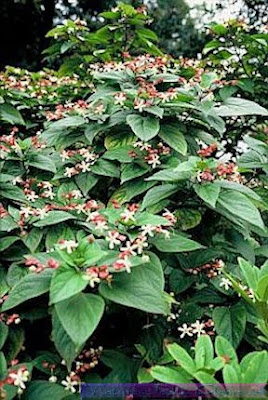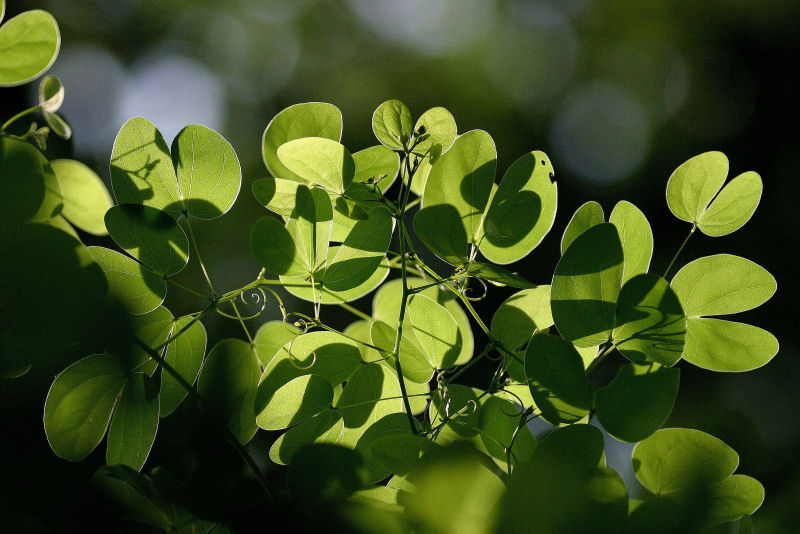Clerodendrum trichotomum
Family: Verbenaceae (ver-be-NAY-see-ee)
Genus: Clerodendrum (kler-oh-DEN-drum)
Species: trichotomum (try-KOH-toh-mum)
Synonym:Clerodendron trichotomum
Synonym:Siphonanthus trichotomum
Genus: Clerodendrum (kler-oh-DEN-drum)
Species: trichotomum (try-KOH-toh-mum)
Synonym:Clerodendron trichotomum
Synonym:Siphonanthus trichotomum

Category:
Shrubs
Trees
Height:
15-20 ft. (4.7-6 m)
Spacing:
15-20 ft. (4.7-6 m)
Hardiness:
USDA Zone 6a: to -23.3 °C (-10 °F)
USDA Zone 6b: to -20.5 °C (-5 °F)
USDA Zone 7a: to -17.7 °C (0 °F)
USDA Zone 7b: to -14.9 °C (5 °F)
USDA Zone 8a: to -12.2 °C (10 °F)
USDA Zone 8b: to -9.4 °C (15 °F)
USDA Zone 9a: to -6.6 °C (20 °F)
USDA Zone 9b: to -3.8 °C (25 °F)
Sun Exposure:
Sun to Partial Shade
Danger:
Seed is poisonous if ingested
Parts of plant are poisonous if ingested
Handling plant may cause skin irritation or allergic reaction
Bloom Color:
Pink
Red
White/Near White
Bloom Time:
Mid Summer
Late Summer/Early Fall
Foliage:
Deciduous
Aromatic
Other details:
Flowers are fragrant
Average Water Needs; Water regularly; do not overwater
Soil pH requirements:
4.6 to 5.0 (highly acidic)
5.1 to 5.5 (strongly acidic)
5.6 to 6.0 (acidic)
6.1 to 6.5 (mildly acidic)
6.6 to 7.5 (neutral)
Propagation Methods:
By dividing the rootball
From softwood cuttings
From semi-hardwood cuttings
From seed; direct sow after last frost
From root stolons
(Stoloniferous-Producing stolons.)
Shrubs
Trees
Height:
15-20 ft. (4.7-6 m)
Spacing:
15-20 ft. (4.7-6 m)
Hardiness:
USDA Zone 6a: to -23.3 °C (-10 °F)
USDA Zone 6b: to -20.5 °C (-5 °F)
USDA Zone 7a: to -17.7 °C (0 °F)
USDA Zone 7b: to -14.9 °C (5 °F)
USDA Zone 8a: to -12.2 °C (10 °F)
USDA Zone 8b: to -9.4 °C (15 °F)
USDA Zone 9a: to -6.6 °C (20 °F)
USDA Zone 9b: to -3.8 °C (25 °F)
Sun Exposure:
Sun to Partial Shade
Danger:
Seed is poisonous if ingested
Parts of plant are poisonous if ingested
Handling plant may cause skin irritation or allergic reaction
Bloom Color:
Pink
Red
White/Near White
Bloom Time:
Mid Summer
Late Summer/Early Fall
Foliage:
Deciduous
Aromatic
Other details:
Flowers are fragrant
Average Water Needs; Water regularly; do not overwater
Soil pH requirements:
4.6 to 5.0 (highly acidic)
5.1 to 5.5 (strongly acidic)
5.6 to 6.0 (acidic)
6.1 to 6.5 (mildly acidic)
6.6 to 7.5 (neutral)
Propagation Methods:
By dividing the rootball
From softwood cuttings
From semi-hardwood cuttings
From seed; direct sow after last frost
From root stolons
(Stoloniferous-Producing stolons.)
General Culture:
Winter hardy to USDA Zones 7-10 where it is grown in organically rich, well-drained soils in full sun to part shade. In St. Louis, it is not reliably winter hardy and, if attempted, should be sited in a protected location with a winter mulch.
Noteworthy Characteristics:
Native to China and Japan, this clerodendrum is a coarse, sometimes unkempt, deciduous shrub or small tree that grows 10-20’ tall. It is most often seen as a suckering shrub. It must be trained to grow as a tree and is rarely seen growing in that form. As an ornamental, this shrub is perhaps best noted for its late summer flowers, showy fruit and malodorous foliage. Tubular, fragrant, white flowers in long-peduncled cymes (to 6-9” across) bloom in the upper leaf axils from late summer into fall. Flowers are followed by small bright blue fruits, each subtended by a fleshy red calyx. Opposite, toothed to entire, ovate, dark green leaves (to 5-8” long) produce no fall color. When bruised, the leaves do produce a unique aroma reminiscent of peanut butter as memorialized by the sometimes used common name of peanut butter tree for this plant. Harlequin glorybower is a more frequently used common name. Clerodendrum comes from the Greek words klero (fate) and dendron (tree), hence the infrequently used common name of fate tree.
Problems:
No serious insect or disease problems.
Uses:
Where winter hardy, grow in shrub borders or woodland margins.
Clerodendron trichotomum is also known as harlequin glorybower. This vigorous shrub or small tree is native to China and Japan, and a spreading shape. It often has multiple trunks. Young twigs are hairy. Leaves appear relatively late, and fall with first frosts.
This tree is ornamental and frost hardy : mature trees can withstand USDA zones 6 frosts.
Winter hardy to USDA Zones 7-10 where it is grown in organically rich, well-drained soils in full sun to part shade. In St. Louis, it is not reliably winter hardy and, if attempted, should be sited in a protected location with a winter mulch.
Noteworthy Characteristics:
Native to China and Japan, this clerodendrum is a coarse, sometimes unkempt, deciduous shrub or small tree that grows 10-20’ tall. It is most often seen as a suckering shrub. It must be trained to grow as a tree and is rarely seen growing in that form. As an ornamental, this shrub is perhaps best noted for its late summer flowers, showy fruit and malodorous foliage. Tubular, fragrant, white flowers in long-peduncled cymes (to 6-9” across) bloom in the upper leaf axils from late summer into fall. Flowers are followed by small bright blue fruits, each subtended by a fleshy red calyx. Opposite, toothed to entire, ovate, dark green leaves (to 5-8” long) produce no fall color. When bruised, the leaves do produce a unique aroma reminiscent of peanut butter as memorialized by the sometimes used common name of peanut butter tree for this plant. Harlequin glorybower is a more frequently used common name. Clerodendrum comes from the Greek words klero (fate) and dendron (tree), hence the infrequently used common name of fate tree.
Problems:
No serious insect or disease problems.
Uses:
Where winter hardy, grow in shrub borders or woodland margins.
Clerodendron trichotomum is also known as harlequin glorybower. This vigorous shrub or small tree is native to China and Japan, and a spreading shape. It often has multiple trunks. Young twigs are hairy. Leaves appear relatively late, and fall with first frosts.
This tree is ornamental and frost hardy : mature trees can withstand USDA zones 6 frosts.

Leaves of the harlequin glorybower are deciduous, simple, entire, opposite and elliptic to ovate. They are about 7-10 in (17-25 cm) long and 2-6 in (5-15 cm) wide. Leave stems can be quite long. When crushed, leaves have an unpleasant odour.
Flowers are white, tubular, red and white, with 4 prominent stamens. They are strongly scented, and grouped in terminal panicles of 6-8 in (15-20 cm) in diameter. Flowers appear on new wood, in mid to late summer.
The fruits are inedible, fleshy and globose, less than 0.5 in (1.25 cm) in diameter, and are bright blue when ripe.
Kingdom Plantae – Plants
Subkingdom Tracheobionta – Vascular plants
Superdivision Spermatophyta – Seed plants
Division Magnoliophyta – Flowering plants
Class Magnoliopsida – Dicotyledons
Subclass Asteridae
Order Lamiales
Family Verbenaceae – Verbena family
Genus Clerodendrum L. – glorybower
Species Clerodendrum trichotomum Thunb. – harlequin glorybower








